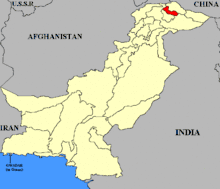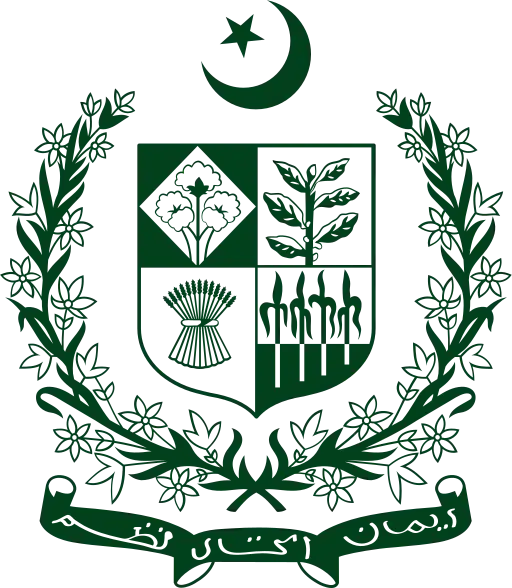| Nagar ریاست نگر | |
|---|---|
| Princely state of Pakistan | |
| 1300s–25 September 1974 | |
 Flag
 Coat of arms
| |
 Map of Pakistan with Nagar highlighted | |
| Capital | Nagar, Pakistan |
| Area | |
• | 5,000 km2 (1,900 sq mi) |
| History | |
• Established | 1300s |
• Disestablished | 25 September 1974 |
| Today part of | Gilgit-Baltistan, Pakistan |
 |
| This article is part of the series |
| Former administrative units of Pakistan |
|---|
Nagar (Urdu: ریاست نگر, Riyasat Nagar) was a princely state located in the northern region of Gilgit–Baltistan, Pakistan. Before August 1947, it maintained a subsidiary alliance with British India. It shared its borders with the Gilgit Agency states to the south and west, while to the north and east, it bordered the princely state of District Hunza. From November 1947 to 1974, Nagar was recognized as a princely state within Pakistan, with its administrative center in the town of Nagar.
The land that was previously part of Nagar now comprises three tehsils within the Nagar District of Northern Pakistan.
History
Nagar, established in the 14th century, operated as an autonomous principality until the British exerted control over the region during the Hunza–Nagar Campaign (1889-1893). Subsequently, it became a colonial princely state under the jurisdiction of the Gilgit Agency until 1947.[1] However, starting in 1868, Nagar was a vassal state under the authority of the Maharaja of Jammu and Kashmir, even though it was never directly governed by Kashmir. The rulers of Nagar were considered to be among the most loyal vassals of the Maharajas of Jammu and Kashmir, sending annual tributes to their Durbars until 1947. The British granted them a Hereditary gun salute of 15-guns.
In November 1947, the ruler, Mir Shaukat Ali Khan acceded Nagar to Pakistan, which became responsible for its external affairs and defense, while Nagar maintained internal self-government. In 1968, Syed Yahya Shah, the first educated politician of the valley, demanded civil rights from the Mir of Nagar. In 1973, when Ayub Khan's dictatorship ended in Pakistan and the Pakistan People's Party (under Zulfiqar Ali Bhutto) was elected, the government forced the Mir of Nagar to abdicate. The area was then merged with the Northern Areas.[2]


Government
The state was governed by the hereditary rulers of the Maglot dynasty, who were styled as Mir. The details of these early rulers are uncertain; the first definite dates available are from 1839. In November 1947, the state became one of the princely states of Pakistan. Brigadier Mir Shaukat Ali Khan was the last ruler of the State before it was abolished by Pakistani PM Zulfiqar Ali Bhutto in 1972.[3]
| Reign | Mirs of Nagar[3] | Notes |
|---|---|---|
| 1660-1700 | Fazil Khan | |
| 1700-1750 | Daud Khan | |
| 1750-1758 | Ali Dad Khan | First reign |
| 1758-1761 | Hari Tham Khan | Shortest serving leader |
| 1761-1770 | Ali Dad Khan | Second reign |
| 1770-1780 | Kamal Khan | |
| 1780-1800 | Rahim Khan I | |
| 1800-1839 | Rahim Khan II | |
| 1839–1891 | Jaffar Zahid Khan | First Reign Longest serving leader |
| 1891-1892 | Raja Ozor Khan | Regency Died 1922 |
| 1892-1904 | Jaffar Zahid Khan | Second reign |
| 1904-1940 | Raja Mir Iskandar Khan | |
| 1940–1974 | Mir Shaukat Ali Khan | |
| 25 September 1974 | Accession into Pakistan | |
| 1974–2003 | Mir Shaukat Ali Khan | |
| 2003– | Mir Barkat Ali Khan | Incumbent |
Population
Demographics
There are around 90,000 inhabitants of the Nagar valley (AKRSP Census, 2000).
Nagar is home to two main ethnic groups – the Burushaski speakers and the Shina speakers. An older type of Burushaski is still spoken in the valley with a mild modern accent. A third language, Bedeski, is also still spoken in Chalt Nagar.
Religion
The population is traditionally predominantly Shia Isna'asheri (Jafaria).
Geography
The terrain of Nagar is extremely mountainous, which provided a certain degree of protection against invading forces. The highest mountain is the 7885 ) Mount Dastagilsar)) of Hisper , south of the town of Nagar. The Karakoram Highway crosses Nagar, connecting Pakistan with China via the Khunjerab Pass. The road follows the Hunza river for some distance through Nagar and into the Hunza region. According to local languages Nagar Valley divided into two parts. Nagar Shinaki and Nagar Burosho.
Villages of Nagar
Shina Speaking Villages in Nagar (Shinaki/Sheenbar)
- Chalat (Paaeen/baala)
- Bar Valley
- Chaprote Valley
- Budalas valley
- Jafarabad Valley
- Nilt Valley
- Thol Valley
- Qasimabad Valley (Masoot)
- Ghulmet Valley
- Yal Valley
- Pissan Valley
- Minapin Valley
Burushaski Speaking Villages in Nagar
- Nagarkhas
- Sumayar Valley
- Sikandar Abad
- Miachar Valley
- Dadimal Valley
- Phakker Valley
- Hakuchar Valley
- Shayar Valley
- Askurdas Valley
- Hoper Valley
- Hisper Valley
Bilingual Valleys in Nagar
- Chalt Paeen Valley
- Akbarabad Valley
- Jafarabad Valley
- Qasimabad Valley (Mascoot)
- Ghulmet Valley
- Pissan Valley
- Minapin Valley
The Nagar villages are mainly populated by religious scholars, Educationists, Sportsmen, Craftsmen and Craftswomen, farmers, hunters and fishermen, handicrafts, miners, Shepherds, adventurers, mountaineers and so on.
References
- ↑ Chisholm, Hugh, ed. (1911). . Encyclopædia Britannica. Vol. 13 (11th ed.). Cambridge University Press. p. 957.
- ↑ Muhammad Ismail Tehseen, Buroshall Say Nagar Tak ka Safar, Syed Yahya Shah, Brushal ke Qabail, both in Urdu, available in Municipal library at Gilgit
- 1 2 "Nagar". chiefacoins.com. Chiefa Coins. Retrieved 15 December 2023.
Further reading
- Mohammad Ismail Nashad, Buroshall say Nagar Tek Ka Safar
- Syed Mohammad Yahya Shah, Rasala Buroshall
- E. F. Knight, Zafar Hayat Paul, Where the Three Empires Meet